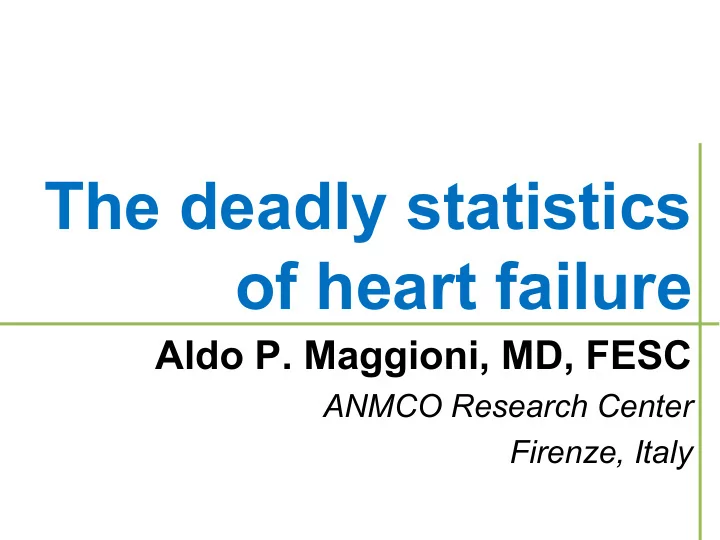

The deadly statistics of heart failure Aldo P. Maggioni, MD, FESC ANMCO Research Center Firenze, Italy
Presenter Disclosures Dr. Maggioni: • Serving in Committees of studies on Heart Failure sponsored by: Bayer, Cardiorentis, Novartis Pharma AG
Agenda • Hospitalized HF patients • Chronic HF patients • Conclusions and perspectives
Agenda • Hospitalized HF patients –The point of view of cardiologists • Chronic HF patients • Conclusions and perspectives
ESC HF Guidelines 2012: Algorithm for Management of Acute Pulmonary Edema/Congestion Acute pulmonary edema/congestion IV bolus of loop diuretic Yes Oxygen Hypoxemia No Yes Severe anxiety/distress Consider IV opiate Measure SBP SBP < 85 mmHg or shock SBP 85-110 mmHg SBP > 110 mmHg Add non-vasodilating No additional therapy Consider vasodilator inotrope until response assessed (e.g. NTG) Please consult published guidelines for additional treatment information. IV = intravenous SBP = systolic blood pressure Adapted from McMurray JJ, et al. Eur J Heart Fail. 2012; 14(8): 803-869.
IN-HF Outcome: 1-year All-Cause Mortality Italy, 61 cardiology centers, year 2009 5610 patients: 33% HHF, 67% CHF Worsening HF: 27.7% De Novo HF: 19.2% Chronic HF: 5.9% Days From Enrollment Tavazzi L, et al. Circ Heart Fail. 2013; 6:473-81 .
ESC Heart Failure Long-Term Registry: Follow-up outcomes 1 year mortality - CHF: 6.4% - HHF: 26.0% From May 2011 to April 2013, 21 countries, 12,440 patients, 40.5% with acute HF (hospitalized patients) and 59.5% with chronic HF (outpatients) EORP: HF Long Term Registry, HFA Congress, Seville 2015
Agenda • Hospitalized HF patients –The point of view of cardiologists –The Real World Evidence • Chronic HF patients • Conclusions and perspectives
Incidence of HF admissions in an Italian community setting in 2010 Total population: 2,970,973 Admission for HF: 8,754 (incidence 3‰ ) Median age: 79 years Female sex: 54.3% ARNO database 2010
Age groups of the total population (A) and of patients admitted for HF (B) <55 years 55-64 years 65-74 years 75-84 years ≥85 years ARNO database 2010
Where are patients managed when admitted to hospital? ARNO database 2010
In-Hospital and 1 year all-cause mortality • In-hospital all-cause mortality: 9.8% • 1- year all-cause mortality: 28.7% ARNO database 2010
Patients with 12-month hospital re-admissions: 4,936/8,239 = 59.9% Total number of readmissions = 7,840 CV reasons n. 4,128 (53%) Non CV reasons n. 3,712 (47%) Total HF ACS Stroke/ Other CV COPD/ Pulmon. Renal Cancer Other TIA reasons Asthma infections failure non CV reasons ARNO database 2010
NHS costs per year for 1 patient admitted for HF = € 10,697 ARNO database 2010
Agenda • Hospitalized HF patients • Chronic HF patients –Patients’ outcomes from 1995 to 2014 • Conclusions and perspectives
INHF IN-HF: Patients disposition 25,743 pts Total population 4,604 pts - enrolled after 2012 - patients with AHF 21,139 pts Total population 18,474 2,665 (87.4%) (12.6%) With follow Lost to -up data follow-up Total Population (n. 21,139) Centers Patients North 43 9,755 Center 24 6,942 South 28 4,442
INHF 1-year all-cause mortality by years of enrollment Overall population (n. 18,474 patients) Multivariable analysis Adjusted HR (95%CI) 1995-2000 1 2001-2004 0.68 (0.58-0.78) 2005-2008 0.54 (0.46-0.64) 9.6% 2009-2012 0.53 (0.44-0.65) 6.4% 5.0% 5.0%
INHF 1-year all-cause mortality by years of enrollment HF reduced EF (<45%) (n. 11,050 patients) Multivariable analysis Adjusted HR (95%CI) 1995-2000 1 2001-2004 0.61 (0.51-0.74) 10.7% 2005-2008 0.49 (0.39-0.61) 2009-2012 0.44 (0.34-0.55) 6.4% 5.3% 4.8%
INHF 1-year all-cause mortality by years of enrollment HF preserved EF (≥45%) (n. 3,215 patients) Multivariable analysis Adjusted HR (95%CI) 1995-2000 1 2001-2004 1.04 (0.63-1.73) 2005-2008 0.52 (0.28-0.96) 2009-2012 0.86 (0.49-1.51) 4.8% 4.5% 4.4% 2.4%
1A Recommended treatments INHF by years of enrollment P for trend = 0.11 88.0% P for trend <.0001 87.1% 86.6% 86.4% 79.7% 59.7% 54.1% P for trend = 0.0005 33.7% 29.2% 27.7% 24.6% 22.9% ACE-I/ARBs Betablockers MRAs 1995-2000 (n. 4749) 2001-2004 (n. 5415) 2005-2008 (n. 4643) 2009-2012 (n. 3667)
Study population: INHF Device implantation by years of enrollment 23.2% P for trend <.0001 P for trend 18.1% <.0001 16.1% 13.6% 11.7% 9.4% 6.4% 5.2% P for trend <.0001 1.5% 1.1% 0.6% 0.4% ICD CRT-P CRT-D 1995-2000 (n. 4749) 2001-2004 (n. 5415) 2005-2008 (n. 4643) 2009-2012 (n. 3667)
Agenda • Hospitalized HF patients • Chronic HF patients • Conclusions and perspectives
Conclusions • Due to the relevant advances in patients’ treatment, outcomes in patients with chronic HF and reduced EF seem to be improved in the last decades • Patients hospitalized for HF have generally a more severe clinical profile than those with chronic HF and a still unacceptably high rate of events • Real world data confirm the clinical relevance of HF and the related burden on public health
Perspectives • Further efforts should be focused on: – Widespread application of recommended treatments in patients with chronic HFrEF – New treatments (and trial methodology) for HHF and HFpEF patients • Research projects should involve not only cardiology centers but also intensive care and internal medicine centers • Due to multiplicity of causes of readmission, to concretely reduce the burden of HF, a multidisciplinary approach is needed
Recommend
More recommend